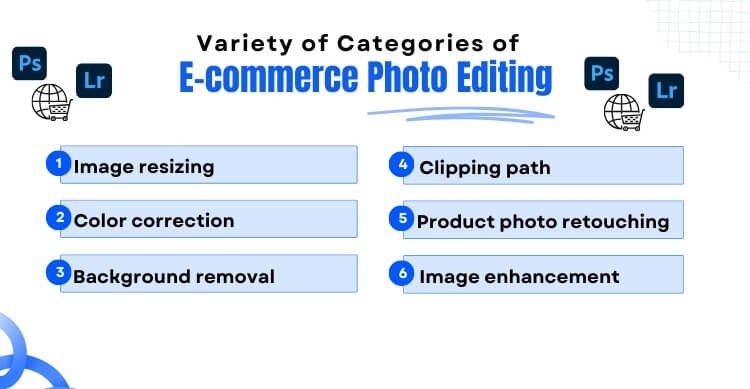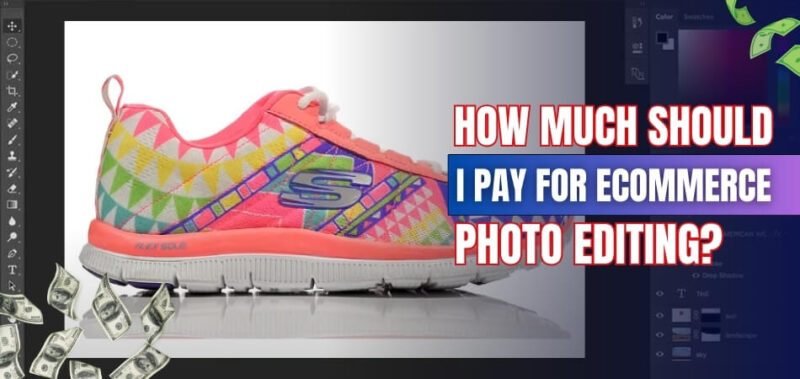The world of e-commerce photo editing piloting can be a bit like wandering through a maze. It’s crucial to strike the perfect balance between cost and quality, especially when your product images are the first thing customers see.
Now, when it comes to professional photography services, the range is broad. These services can elevate your product images from good to great, ensuring they grab attention and drive sales. But here’s the burning question: How much should I pay for ecommerce photo editing?
The range varies, you can edit photos from 39 cents to 1 $ per photo. Also, for basic to mid-level edits, an hourly rate of $20 to $50 is reasonable, while more advanced editing might start at $50 to $100 or even higher.
Want to reveal the hidden secrets? Stick around as we dive deeper into this topic and help you make informed decisions for your e-commerce business.
The Essence of E-commerce Photo Editing
E-commerce photo editing is a game-changer in the online shopping world. It’s all about making your product images pop, capturing the essence of what you’re selling.
While you’re scrolling through a website, a beautifully edited image catches your eye. That’s the power of effective E-commerce photo editing. It’s not just about making images look pretty; it’s about telling a story, evoking emotions, and ultimately, driving sales.

Now, you might wonder why it’s so crucial. Well, in the digital age, your product images are your storefront. They create that crucial first impression. With the right editing, you can highlight key features, set the right mood, and make your products irresistible.
It’s a blend of art and marketing that can make all the difference in the competitive world of e-commerce. So, whether you’re a small business owner or a big brand, mastering e-commerce photo editing can be your ticket to success.
Variety of Categories of E-commerce Photo Editing
When it comes to E-commerce product photo retouching, one size definitely doesn’t fit all. Different products and brands call for different styles and techniques. Let’s dive into the various types of editing that can take your product images to the next level.

Background Removal
This is all about making your product stand out. By removing distractions, you can focus attention solely on the product. It’s perfect for creating a clean, consistent look across your website.
Color Correction
Ever noticed how colors can look different in photos? Color correction ensures that your product images have accurate, vibrant colors. It’s crucial for maintaining consistency and making sure your products look as good online as they do in real life.
Retouching Effects
This is where the magic happens. Retouching can fix imperfections, enhance details, and make your products look their absolute best. It’s like giving your images a mini makeover to show off their best features.
Each of these editing types serves a unique purpose in the world of e-commerce. By understanding and using them effectively, you can create product images that not only look great but also drive sales and build your brand.
Can I Edit E-commerce Photos By Myself?
Yes, you absolutely can edit ecommerce photos by yourself! With the right tools and a bit of practice, you can transform your product images into professional-looking shots that captivate your audience. Let’s explore some key factors to consider if you’re planning to take the DIY route.

Learning Curve
It requires a certain level of skill and understanding of editing software to edit photos. While it’s definitely achievable, be prepared to invest some time in learning the ropes. There are plenty of tutorials and resources available online to help you get started.
Time Investment
Also, this can be time-consuming to edit photos, especially if you have many products. Consider whether you have the time to dedicate to editing or if it might be more efficient to outsource this task.
Quality Expectations
While you can achieve great results on your own, professional photo editors have the experience and tools to take your images to the next level. Assess your quality expectations and decide if self-editing meets your standards for your e-commerce site.
For all these reasons, editing e-commerce photos by yourself is definitely doable, but it’s important to weigh the factors of learning curve, time investment, and quality expectations. With some dedication and practice, you can create stunning product images that enhance your online store.
Where Can I Edit E-commerce Photos Professionally?
If you’re looking to give your e-commerce photos a professional touch, you’re in luck! Several platforms and services can help you achieve stunning results. Let’s dive into some options where you can edit your e-commerce photos like a pro.
Online Editing Tools
Websites like Canva and PicMonkey offer user-friendly interfaces and a variety of editing tools. They’re great for basic edits like cropping, resizing, and color adjustments. Plus, they often come with pre-designed templates to make your life easier.
Professional Software
For more advanced editing, software like Adobe Photoshop and Lightroom is the way to go. They offer a wide range of tools for detailed retouching, color correction, and background removal. While there’s a steeper learning curve, the results can be truly impressive.
Photo Editing Services
If you’re short on time or prefer to leave it to the experts, consider using a professional photo editing service. Visual Sparrow is one of the leading services in the market, known for its high-quality edits and quick turnaround times. They can handle everything from basic edits to complex retouching, ensuring your photos look their best.
Whether you choose an online tool, professional software, or a dedicated service, there’s an option out there to suit your needs and skill level. With the right resources, you can cultivate your e-commerce photos to professional standards and make your products shine.
How Much Should I Pay for Ecommerce Photo Editing?
It is a balancing act to determine how much to pay for e-commerce photo editing. You want your product images to look top-notch, but you also need to keep an eye on your budget. So, how much should I pay for ecommerce photo editing?

The response isn’t universal, but it generally depends on the complexity of the edits and the expertise of the editor. Generally, it starts from 39 cents to 1 dollar per image to edit an e-commerce photo, depending on certain factors. To help you maneuver this, let’s break down some key points to consider.
Type of Editing Required
The cost of photo editing can vary greatly depending on the type of edits needed. Basic adjustments like color correction and cropping might be more affordable, while advanced retouching or background removal can cost more. Assessing the level of editing your photos requires getting a clearer idea of the potential costs.
Volume of Images
If you have a large volume of images that need editing, you might be able to negotiate a bulk rate with your editor or service. This can be more cost-effective than paying per image, especially for ongoing projects or regular updates to your e-commerce site.
Experience and Skill Level of the Editor
The expertise of the photo editor plays a significant role in determining the price. A seasoned professional with a strong portfolio is likely to charge more than a beginner. However, their experience can also translate into higher-quality edits and a better understanding of your brand’s aesthetic.
Turnaround Time
If you need your edited photos quickly, you might have to pay a premium for expedited service. You should communicate your deadlines upfront and factor in any additional costs for rush jobs.
Software and Tools Used
The quality of the editing software and tools used can also impact the cost. Professional-grade software like Adobe Photoshop tends to produce superior results, but it also comes with a higher price tag. Ensure to inquire about the tools your editor uses to ensure they meet your standards.
Revisions and Feedback
Consider whether the editing service includes revisions in their pricing. Being able to request changes without incurring extra fees can be valuable, especially if you’re particular about your brand’s image.
Licensing and Usage Rights
Ensure you understand the licensing and usage rights associated with the edited photos. Some services may charge more for full commercial rights, so it’s crucial to clarify this beforehand to avoid any surprises.
The cost of e-commerce photo editing can vary from a few dollars per image for basic edits to higher rates for more complex work. In that case, you can consider the factors mentioned above and get quotes from different editors or services.
This will enable you to find the best fit for your needs and budget. Investing in quality photo editing can enhance your product presentation and contribute to your e-commerce business success.
Tips to Negotiate Prices with the Professional Editor
The key to negotiating prices with a professional editor is to find that sweet spot where both parties are satisfied. Here are some tips to help you get the most affordable deal without compromising on quality.
- Know Your Budget: Before you start negotiating, have a clear idea of your budget. This will help you set boundaries and make realistic offers.
- Do Your Homework: Research the going rates for the type of editing you need. Having this knowledge will give you a solid foundation for negotiation.
- Be Clear About Your Needs: Clearly outline the scope of your project, including the number of images, the level of editing required, and your deadlines. This clarity can prevent misunderstandings and help you get a more accurate quote.
- Ask for Bulk Discounts: If you have a large volume of images, inquire about bulk discounts. Editors are often more flexible with pricing for bigger projects.
- Offer Long-Term Partnership: If you plan to have ongoing editing needs, mention the possibility of a long-term partnership. Editors might offer better rates for the promise of steady work.
- Be Polite and Professional: Negotiations should always be conducted with respect and professionalism. A positive attitude can go a long way in securing a favorable deal.
Don’t forget, that the goal of negotiation is to reach an agreement that’s fair to both you and the editor. With the right approach, you can ensure your images are edited to perfection without breaking the bank.
FAQs About How Much Should I Pay for Ecommerce Photo Editing?
When it comes to e-commerce photo editing, several frequently asked questions come to mind. Here are some common queries along with their answers to help you make informed decisions about your photo editing needs:
Is Paying for an Editor Worth It for E-commerce Photo?
Yes, investing in a professional editor is worth it. High-quality images can significantly enhance the appeal of your products, leading to increased customer engagement and sales.
Should I Opt for Per-image Pricing or Hourly Rates?
This depends on your specific needs. Per-image pricing is straightforward and works well for small projects, while hourly rates might be more cost-effective for extensive or ongoing editing work.
How Can I Ensure I’m Getting a Good Deal?
Do your research, compare quotes from different editors, and don’t be afraid to ask for a breakdown of costs. Also, look for editors who offer revisions as part of their pricing, as this can provide added value.
What’s the Difference Between Basic and Advanced Photo Editing?
Basic editing includes simple adjustments like cropping, color correction, and brightness/contrast tweaks. Advanced editing involves more complex tasks such as retouching, background removal, and image manipulation.
Conclusion
There is no definitive answer to the question “How much should I pay for ecommerce photo editing?”. The cost depends on various factors such as the complexity of the edits, the volume of images, and the editor’s expertise.
To ensure a smooth process, you should be clear about your needs, research market rates, and consider negotiating prices. This is especially true for bulk orders.
As a reminder, investing in quality photo editing can significantly enhance the appeal of your products. It’s worth finding the right balance between cost and quality to make your e-commerce images stand out.
